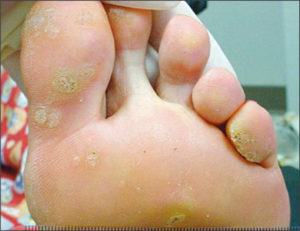IT’S A BUMP!
Runners can get some pretty gnarly lumps and bumps on their feet. Calluses and corns are common, manageable annoyances that runners can live with or work around. But every once in a while a growth may not be running-related and may need immediate attention. How can you sort out what you can and cannot live with? Best to see your doctor for an official diagnosis. And if your doctor cannot tell definitively what is going on, then see a dermatologist and a foot specialist. Here are some considerations:
COMMON FOOT “LUMPS AND BUMPS”
Bone

Degenerative changes can cause bone overgrowth at or around joints. Along with pain, these can present as firm bumps at or adjacent to any joint in the foot. Common locations include the great toe and the top of the midfoot. Bunions are deformities that cause large bony bumps at the base of the big tie, on the side of the foot. Chronic inflammation from tight muscles pulling on bone attachments can cause bone spurs. Common locations include the heel (Achilles tendon/calcaneus bone) and the outside of the foot (peroneus tendon/5th metatarsal). Bone injuries from fractures or stress reactions can cause a lump in the body or shaft of the affected bone. Be aware that bone tumors can also cause lumps.
Skin


There is a variety of lumps and bumps that can develop around the skin. Blisters form soft, tender, fluid-filled skin lumps from shoes or socks sliding across the foot or from toes rubbing together. Calluses and corns are focal areas of firm, thickened skin that can develop from friction or weight-related stress over pressure points where a bone prominence pushes against skin. Infections can also develop in the skin of the foot.
Plantar warts are discrete thickenings in the skin surface similar to calluses/corns but are caused by viral infections. Bacteria can suddenly form painful soft, tender skin abscesses. Small, itchy, superficial bumps on the bottom of the foot can occur from an allergic rash called dyshidrotic eczema.
Muscles/Tendons

The muscles in the foot are prone to get aggravated from rubbing or pressure from your shoe. A bump can form where the rubbing occurs from tendon damage and swelling, and this can become painful. Thick bumps called fibromas similar to scar tissue can form along the bottom of the foot in the plantar fascia.
Cysts


Fluid-filled cysts can form near tendons or joints. They are typically solid or fluid-filled pouches from the sheaths surrounding joints or tendons that fill up with fluid. They are usually benign, but should be checked out by a doctor.
Tumor

A tumor is an overgrowth of tissue that can be benign or cancerous. Tumors can occur anywhere on or in the foot. Obviously, a cancerous tumor must be removed, but even benign tumors should be removed if they are growing large or interfere with normal foot motion.
Testing For "Lumps and Bumps"
Fortunately, most foot bumps have characteristic locations and appearances and can be easily diagnosed by a foot or sports specialist with no additional testing needed. X-rays are done when bone- related issues are suspected. Anytime the diagnosis is uncertain, advanced imaging such as ultrasound, CT scan, or MRI may be needed.
Treatment for "Lumps and Bumps"
Depending on the cause of the lump or bump, treatment will vary widely. Infections can be treated with the appropriate antibiotic treatments. Many masses like tumors may have to be excised or treated by a medical specialist to resolve. Otherwise, many benign lumps or bumps that do not interfere with function and are not too painful can be controlled with good footwear, activity modifications, and other simple treatments. A cortisone injection usually will NOT be appropriate for most lumps and bumps, but drainage of fluid from cysts may be indicated.
RECENT BLOG POST
TAPING YOUR INJURIES!
Taping has long been used by physical therapists and athletic trainers to treat various sports-related musculoskeletal injuries. Kinesiology taping is a modernized method of taping, popularized by its
